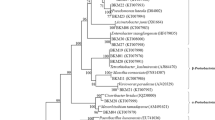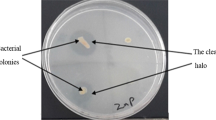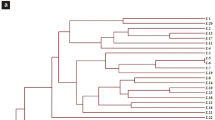Abstract
In this study, experiments were conducted to isolate, characterize, and evaluate rice rhizosphere bacteria for their arsenic (As) tolerance ability and zinc (Zn) solubilization potential in culture media and soil. Among 20 bacterial isolates recovered, six were found to solubilize inorganic Zn salt(s) efficiently under in vitro culture conditions. 16S rRNA gene sequence-based phylogenetic analysis indicated the affiliation of efficient Zn solubilizing bacteria (ZSB) to Burkholderia vietnamiensis and Burkholderia seminalis. Zinc solubilizing efficiency (ZSE) of the bacteria varied with the concentrations and types of Zn salts used in the experiments. Increasing trend in ZSE of the bacteria was noticed when the percentage of ZnO increased from 0.1 to 0.5 but the same decreased at 1.0%. Increased Zn solubilization was noticed when bacteria were incubated with lower concentration of Zn3(PO4)2 and ZnCO3. In general, Zn solubilization increased with increasing incubation time in lower volume medium, while some isolates failed to solubilize one or more tested Zn salts. However, enriched concentrated cells of the ZSB in glucose amended medium with 0.5% ZnO showed an increasing trend of Zn solubilization with time and were able to solubilize more than 300 mg/L Zn. This increased rate of Zn release by the ZSB was attributed to marked decline in pH that might be due to the enhanced gluconic acid production from glucose. As evident from the decreased ZSE of the bacteria in the presence of As(V) in particular, it seems arsenic imparts a negative effect on Zn solubilization. The ZSB were also able to increase the rate of Zn release in soil. A microcosm-based soil incubation study amending the enriched bacteria and 0.5% ZnO in soil showed an elevated level of both water-soluble and available Zn compared to un-inoculated control. During Zn solubilization in microcosms, viable cells in terms of colony-forming unit (CFU) declined by the same order of magnitude both in the presence and absence of ZnO that might be due to the nutrients limiting condition aroused during the incubation period rather than Zn toxicity. The bacteria in this study also exhibited plant growth promoting traits, such as growth in nitrogen-free medium, production of indole acetic acid (IAA), and solubilization of potassium and phosphate. Our findings suggested that Burkholderia spp. could be the potential candidates for enhancing Zn dissolution in the soil that might reduce the rate of inorganic Zn fertilization in agricultural soil.






Similar content being viewed by others
References
Abou-Shanab RA, vanBerkum P, Angle JS (2007) Heavy metal resistance and genotypic analysis of metal resistance genes in grampositive and gram-negative bacteria present in Ni-rich serpentine soil and in the rhizosphere of Alyssum murale. Chemosphere 68:360–367
Ahmed AMA, Ahmed G, Magda MH, TawfikIntegrated MM (2011) Effect of organic and biofertilizers on wheat productivity in new reclaimed soils. Res J Agric Biol Sci 7:105–114
Andreini C, Bertini I, Rosato A (2009) Metalloproteomes: a bioinformatic approach. AccChem Res 42:1471–1479
Araújo FD, Araújo WL, Eberlin MN (2017) Potential of Burkholderia seminalis TC342R3 as biocontrol agent against Fusariumoxysporum evaluated by mass spectrometry imaging. J Am Soc Mass Spectrom 28:901. https://doi.org/10.1007/s13361-017-1610-6
Alloway BJ (2009) Soil factors associated with zinc deficiency in crops and humans. Environ Geochem Health 31:537–548
Bapiri A, Asgharzadeh A, Mujallali H, Khavazi K, Pazira E (2012) Evaluation of zinc solubilization potential by different strains of fluorescent pseudomonads. J Appl Sci Environ Manag 16:295–298
Bashri G, Patel A, Singh R, Parihar P, Prasad SM (2017) Mineral solubilization by microorganism: mitigating strategy in mineral deficient soil. Microbial Biotechnol. https://doi.org/10.1007/978-981-10-6847-8_12
Bhakat K, Chakraborty A, Islam E (2019) Characterization of arsenic oxidation and uranium bioremediation potential of arsenic resistant bacteria isolated from uranium ore. Environ Sci Pollut R 26:12907–12919. https://doi.org/10.1007/s11356-019-04827-6
Brocklehurst KR, Morby AP (2000) Metal-ion tolerance in Escherichia coli: analysis of transcriptional profiles by gene-array technology. Microbiology 146:2277–2282. https://doi.org/10.1099/00221287-146-9-2277
Chakraborty A, Bhakat K, Islam E (2017) Arsenic contamination in agricultural soil reduces metabolic activity of total and free-living nitrogen-fixing bacteria as revealed by real-time qPCR. Soil Sediment Contam 26:736–748
Chakraborty A, Islam E (2018) Temporal dynamics of total and free-living nitrogen-fixing bacterial community abundance and structure in soil with and without history of arsenic contamination during a rice growing season. Environ Sci Pollut Res 25:4951–4962. https://doi.org/10.1007/s11356-017-0858-5
Coenye T, Goris J, Spilker T et al (2002) Characterization of unusual bacteria isolated from respiratory secretions of cystic fibrosis patients and description of Inquilinuslimosus gen nov., sp. nov. J Clin Microbiol 40(6):2062–2069
Costerousse B, Schönholzer-Mauclaire L, Frossard E, Thonar C (2018) Identification of heterotrophic zinc mobilization processes among bacterial strains isolated from wheat rhizosphere (TriticumaestivumL.). Appl Environ Microbiol 84:01715–01717. https://doi.org/10.1128/AEM.01715-17
Deris ZZ, Van Rostenberghe H, Habsah H et al (2010) First isolation of Burkholderiatropica from a neonatal patient successfully treated with imipenem. Int J Infect Dis 14(1):e73–e74
Dinesh R, Srinivasan V, Hamza S, Sarathambal C, Gowda SA, Ganeshamurthy AN, Gupta SB, Nair VA, Subila KP, Lijina A, Divya VC (2018) Isolation and characterization of potential Zn solubilizing bacteria from soil and its effects on soil Zn release rates, soil available Zn and plant Zn content. Geoderma 321:173–186
Eberl L, Vandamme P (2016) Members of the genus Burkholderia: good and bad guys. F1000Research, 5, F1000 Faculty Rev-1007. https://doi.org/https://doi.org/10.12688/f1000research.8221.1
Estrada-delos Station P, Bustitio-Cristales R, Caballero-Mallado J (2001) Burkholderia, a genus rich in plant-associated nitrogen fixers with wide environmental and geographic distribution. Appl Environ Microbiol 67:279–2798
Fasim F, Ahmed N, Parsons R, Gadd GM (2002) Solubilization of zinc salts by a bacterium isolated from the air environment of a tannery. FEMS Microbiol Lett 213:1–6
Figueiredo MV, Burity HA, Martı´nez CR, Chanway CP (2008) Alleviation of drought stress in the common bean (Phaseolus vulgaris L) by co-inoculation with Paenibacillus polymyxa and Rhizobium tropici. Appl Soil Ecol 40:182188
Gandhi A, Muralidharan G (2016) Assessment of zinc solubilizing potentiality of Acinetobacter sp. isolated from rice rhizosphere. Eur J Soil Biol 76:1–8
Gerrits GP, Klaassen C, Coenye T et al (2005) Burkholderia fungorum septicemia. Emerg Infect Dis 11(7):1115–1117
Gillis M, Van TV, Bardin R, Goor M, Hebbar P, Willems A, Segers P, Kersters K, Heulin T, Fernandez MP (1995) Polyphasic taxonomy in the genus Burkholderia leading to an emended description of the genus and proposition of Burkholderia vietnamiensis sp. nov for N2-fixing isolates from rice in Vietnam. Int J Syst Bacteriol 45:274–289
Gontia-Mishra I, Sapre S, Tiwari S (2017) Zinc solubilizing bacteria from the rhizosphere of rice as prospective modulator of zinc biofortification in rice. Rhizosphere 3:185–190
Goswami D, Parmar S, Vaghela H, Dhandhukia P, Thakker J (2015) Describing Paenibacillus mucilaginosus strain N3 as an efficient plant growth promoting rhizobacteria (PGPR). Cogent Food Agric 1:1000714
Govindarajan M, Balandreau J, Kwon S-W, Weon H-Y, Lakshminarasimhan C (2008) Effects of the inoculation of Burkholderia vietnamensis and related endophyticdiazotrophic bacteria on grain yield of rice. MicrobEcol 55:21–37
Gray EJ, Smith DL (2005) Intracellular and extracellular PGPR: commonalities and distinctions in the plantbacterium signaling processes. Soil Biol Biochem 37:395412
Hendershot WH, Lalande H, Duquette M (2007) Soil Reaction and Exchangeable Acidity. In M. R. Carter and E. G. Gregorich, editors. Soil sampling and methods of analysis. Second edition. CRC Press, Taylor & Francis Group, Boca Raton, Florida, USA.
Hotz C, Brown KH (2004) Assessment of the risk of zinc deficiency in populations and options for its control. Food Nutr Bull 25:94–204
Hu XF, Chen J, Guo JF (2006) Two phosphate-and potassium-solubilizing bacteria isolated from Tianmu Mountain, Zhejiang, China. World J Microbiol Biotechnol 22:983–990
Kamran S, Shahid I, Baig DN, Rizwan M, Malik KA, Mehnaz S (2017) Contribution of zinc solubilizing bacteria in growth promotion and zinc content of wheat. Front Microbiol 8:2593. https://doi.org/10.3389/fmicb.2017.02593
Kanwar JS (1973) Soil Fertility-Theory and Practice. Publ. Indian Council of Agricultural Research, New Delhi.
Katyal JC, Sharma BD (1991) DTPA extractable and total Zn, Cu, Mn and Fe in Indian soils. Geoderma 49:165–179
Khanghahi MY, Ricciuti P, Allegretta I, Terzano R, Crecchio C (2018) Solubilization of insoluble zinc compounds by zinc solubilizing bacteria (ZSB) and optimization of their growth conditions. Environ Sci Pollut Res 25:25862–25868
Krithika S, Balachandar D (2016) Expression of zinc transporter genes in rice as influenced by zinc-solubilizing Enterobacter cloacae strain ZSB14. Front Plant Sci 7:446
Kumar A, Dewangan S, Lawate P, Bahadur I, Prajapati S (2019) Zinc-Solubilizing Bacteria: A Boon for Sustainable Agriculture. Microorganisms for Sustainability. Plant Growth Promoting Rhizobacteria for Sustainable Stress Management https://doi/org/https://doi.org/10.1007/978-981-13-6536-2_8
Lee LJ, Barrett JA, Poole RK (2005) Genome-wide transcriptional response of chemostat cultured Escherichia coli to zinc. J Bacteriol 187:1124–1134. https://doi.org/10.1128/JB.187.3.1124-1134.2005
Li J, Ren X, Fan B, Huang Z, Wang W, Zhou H, Lou Z, Ding H, Lyu J, Tan G (2019) Zinc toxicity and iron-sulfur cluster biogenesis in Escherichia coli. Appl Environ Microbiol 85:01967–02018. https://doi.org/10.1128/AEM.01967-18
Li WC, Ye ZH, Wong MH (2010) Metal mobilization and production of short-chain organic acids by rhizosphere bacteria associated with a Cd/Zn hyperaccumulating plant, Sedum alfredii. Plant Soil 326:453–467
Louden BC, Haarmann D, Lynne AM (2011) Use of blue agar CAS assay for siderophore detection. J Microbiol Biol Educ 12:51–53
Mumtaz MZ, Ahmad M, Jamil M, Hussain T (2017) Zinc solubilizing Bacillus spp. potential candidates for biofortification in maize. Microbiol Res 202:51–60
Nahas E (1996) Factors determining rock phosphate solubilization by microorganisms isolated from soil. World J Microbiol Biotechnol 12(6):567–572
Othman NMI, Othman R, Saud HM, Wahab PEM (2017) Effects of root colonization by zinc-solubilizing bacteria on rice plant (Oryza sativa MR219) growth. Agric Nat Resour 51:532–537
Pikovskaya RI (1948) Mobilization of phosphorus in soil connection with the vital activity of some microbial species. Microbiology 17:362–370
Ponnamperuma FN, Caylon MT, Lantin RS (1981) Dilute hydrochloric acid as an extractant for available zinc, copper and boron in rice soils. Plant Soil 61:291–310
Ramesh A, Sharma SK, Sharma MP, Yadav N, Joshi OP (2014) Inoculation of zinc solubilizing Bacillus aryabhattai strains for improved growth, mobilization and biofortification of zinc in soybean and wheat cultivated in vertisols of central India. Appl Soil Ecol 73:87–96
Rattan RK, Shukla LM (1984) Critical limits of deficiency and toxicity of zinc in paddy in a typic Ustipsamment. Commun Soil Sci Plant Anal 15(9):1041–1050. https://doi.org/10.1080/00103628409367541
Rokhbakhsh-Zamin F, Sachdev D, Kazemi-Pour N, Engineer A, Pardesi KR, Zinjarde S, Dhakephalkar PK, Chopade BA (2011) Characterization of plant-growth-promoting traits of Acinetobacter species isolated from rhizosphere of Pennisetumglaucum. J Microbiol Biotechnol 21:556–566
Saravanan VS, Madhaiyan M, Thangaraju M (2007) Solubilization of zinc compounds by the diazotrophic, plant growth promoting bacterium Gluconacetobacter diazotrophicus. Chemosphere 66:1794–1798
Sawar M, Kremer RJ (1995) Determination of bacterially derived auxins using a microplate method. Lett Appl Microbiol 20:282–285
Shaikh S, Saraf M (2017) Biofortification of Triticum aestivum through the inoculation of zinc solubilizing plant growth promoting rhizobacteria in field experiment. Biocatal Agric Biotechnol 9:120–126
Shakeel M, Rais A, Hassan MN, Hafeez FY (2015) Root associated Bacillus sp improves growth, yield and zinc translocation for Basmati Rice (Oryza sativa) varieties. Front Microbiol 6:1286. https://doi.org/10.3389/fmicb.2015.01286
Sharma SK, Sharma MP, Ramesh A, Joshi OP (2012) Characterization of zinc-solubilizing Bacillus isolates and their potential to influence zinc assimilation in soybean seeds. J Microbiol Biotechnol 22:352–359. https://doi.org/10.4014/jmb.1106.05063
Sharma A, Patni B, Shankhdhar D, Shankhdhar SC (2013) Zinc - an indispensable micronutrient. Physiol Mol Biol Plants 19:11–20. https://doi.org/10.1007/s12298-012-0139-1
Shinjo R, Uesaka K, Ihara K, Sakazaki S, Yano K, Kondo M, Tanaka A (2018) Draft genome sequence of Burkholderia vietnamiensis strain RS1, a nitrogen-fixing endophyte isolated from sweet potato. Microbiol Resour Announc 7:00820–00918. https://doi.org/10.1128/MRA.00820-18
Vidyashree DN, Muthuraju R, Panneerselvam P, Saritha B, Ganeshamurthy AN (2016) Isolation and characterization of zinc solubilizing bacteria from stone quarry dust powder. Int J Agri Sci 8:3078–3081
Wu TY, Gruissem W, Bhullar NK (2019) Targeting intracellular transport combined with efficient uptake and storage significantly increases grain iron and zinc levels in rice. Plant Biotechnol J 17:9–20
Zhang X, Jiang B, Ma Y (2017) Aging of zinc added to soils with a wide range of different properties: factors and modeling. Environ Toxicol Chem 36:2925–2933
Acknowledgements
We thankfully acknowledged the received of Grant from DST-SERB (File No. EMR/2016/003761), Government of India for carrying out this research work. A support from DST-PURSE, University of Kalyani, is also highly acknowledged.
Author information
Authors and Affiliations
Corresponding author
Ethics declarations
Conflict of interest
All authors declare no conflict of interest.
Additional information
Publisher's Note
Springer Nature remains neutral with regard to jurisdictional claims in published maps and institutional affiliations.
Supplementary Information
Below is the link to the electronic supplementary material.
Rights and permissions
About this article
Cite this article
Bhakat, K., Chakraborty, A. & Islam, E. Characterization of zinc solubilization potential of arsenic tolerant Burkholderia spp. isolated from rice rhizospheric soil. World J Microbiol Biotechnol 37, 39 (2021). https://doi.org/10.1007/s11274-021-03003-8
Received:
Accepted:
Published:
DOI: https://doi.org/10.1007/s11274-021-03003-8




